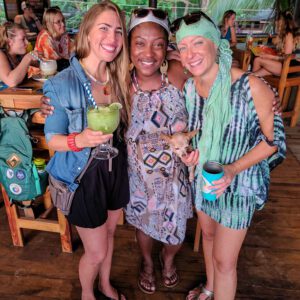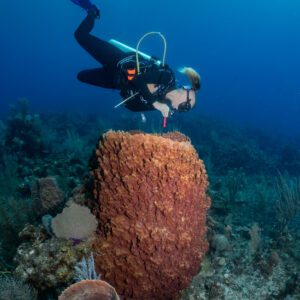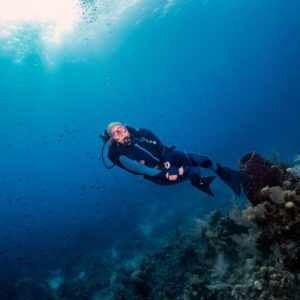July, 2022
Let’s talk about sexual coral restoration, baby!
The Roatan Marine Park (RMP) is using some “sexy” new technology to scale up coral restoration efforts. We’re excited to be a part of this cutting edge approach to coral restoration in Roatan.
On July 21 – 26, Sun Divers customers and team members worked with restoration leaders from RMP to monitor coral spawning activity. The six-day volunteer event was conducted to confirm spawning times for Diploria labyrinthiformis, commonly known as grooved brain coral, so that in the future, the gamete (male & female germ cells) could be collected for coral breeding restoration efforts.
So, how do corals breed?!
Corals have a gift of growing and reproducing both sexually and asexually.
Let’s talk about asexual reproduction first. When coral fragments are broken off from their primary colony either through natural causes or with intent for restoration, they can reattach to the reef and start a whole new colony.
Corals also reproduce sexually. This occurs through mass coral spawning events. Hard (or stony) corals release male & female germ cells called gamete all at the same time. The lucky gamete then fertilize. And, much like we learned about in junior high, they become an embryo that turns into coral larvae (also known as planula). Or if you want to keep the sex ed analogies going, you can think of these as little coral ‘babies.’ The planula can then attach to substrate and ultimately grow into a new colony.
What is coral breeding restoration?
For decades, restoration practices, including those in Roatan, have taken advantage of coral’s asexual superpowers, and “propagated” corals by cutting fragments, growing them in a coral nursery, and then outplanting them onto the reef.
While this restoration practice has a solid success rate, it is costly and time consuming. It also requires significant physical space, and manpower.
New technologies are now allowing us to lend corals a helping hand when it comes to the success rate of their sexual reproduction. Specifically in Roatan, SECORE International, a global coral restoration organization, is bringing tools, techniques and talent to help our community increase its efforts in sexual coral restoration.
Most simply, the method used by SECORE International, RMP and local volunteers like ourselves involves these five primary steps:
- Data is collected to confirm coral spawning times for keystone species
- Once a particular species’ spawning time is confirmed, the next time the spawning event happens, the gametes are collected. The corals are covered by a net with a plastic vile that the gamete float up into for collection.
- Gametes are taken to a land-based lab, where they are cross-bred with the hopes of fertilization. Think of this as IVF for corals.
- Coral larvae attach to substrate blocks developed by SECORE and are then kept in Coral Rearing In-Situ Basins (CRIBs) in the ocean.
- Once starter colonies are developed, the blocks are then “seeded” onto the reef. This requires no manual attachment, which can many times be the most time consuming, as well as error-fraught part of the traditional outplanting method.
The in-situ cribs only require 5% of the labor that land based facilities require, and the substrate to seeding method allows major scaling of coral coverage.
How is Sun Divers supporting?

Sun Divers volunteers on their way to monitor. Photo credit: Gil Sassi
As part of our support of the Roatan Marine Park and local coral restoration efforts, Sun Divers contributed boats, tanks, captain time to coral spawning monitoring of grooved brain coral. 18 coral colonies were monitored by over 20 volunteers. These volunteers were trained on how to properly net the corals and collect gamete in the event of a mass spawning event. Unfortunately, one sole coral spawned, but the monitoring provided valuable data to help RMP predict future spawning events.
“Conservation brings science and the community together, so monitoring coral spawning with the diving community is critical for long-term coral restoration efforts and giving our Roatan reef hope. We are grateful to the local dive shops on Roatan, such as Sun Divers, for collaborating with us on these sustainability efforts,” RMP Research Project Coordinator Damaris Dueñas said.
What’s involved in coral spawning monitoring?
A coral spawning monitoring dive is both scientific and entertaining. It’s basically a two-hour (yes, two full hours!) dusk or night dive conducted in a small area where the majority of your focus is on 1-2 coral colonies waiting for that after-dark magic to happen. But while you have one eye on your colonies, you can also focus more intently than on fun dives where you have to keep moving, and watch the reef come to life. If you love macro diving, you’ll love this because you have all the time in the world to let your eyes adjust and discover the interconnected nature of corals, gobies, blennies, crabs, shrimps, pipehorses and more. See the slideshow below for some of our cool findings on one of the dives. Larger life will also pass you by including Eagle Rays, octopus and schools of fish – the butterfly fish seem particularly inquisitive!
Okay, but back to the work at hand. While you’re monitoring, you’ll be capturing important data on an underwater slate including documenting the start & stop time of spawning should it occur.
If spawning occurs, gametes are collected and that’s when the on-land cross-fertilization happens.
How can I get involved?
RMP will continue to conduct coral spawning monitoring with the hopes of kicking off a concerted coral breeding restoration program. If you’d like to get involved you can contact the Roatan Marine Park and Sun Divers to get more details on future opportunities.
We’ll also continue to offer the RMP Coral Restoration Ambassador certification to support the traditional coral nursery maintenance and outplanting. And this is a great way to get involved when coral spawning is not occurring.
What’s next for sexual coral restoration?

Substrates for sexual coral restoration at Overheat dive site. Photo credit: RMP
Coral spawning monitoring and gamete collection will continue into this year. If you see these substrates pictured right at sites like
Overheat, please do not touch or move them as they are part of the coral restoration efforts.
For the next five years, SECORE International will train, mentor and provide coral breeding restoration tools to the Roatan community so that ultimately we can become self-sufficient in managing coral breeding restoration.
Second Annual Dip & Sip doubles funds raised for girls in Roatan
By Natalie Shuman

The women behind the Dip & Sip (from left to right): Sun Divers Owner Natalie Shuman, Sundowners Owner Christine Etches, and RPHE Co-founder and Vice Mayor Trudy Hilton.
When the idea for the Dip & Sip came to me in 2021, it came from a desire to create an event that would nurture lasting memories and friendships, but also have a larger, positive ripple effect reaching the women and girls across the island.
I had an idea, but had just joined the community and had no clue where to start. I approached Christine Etches, owner of Sundowners with the concept and her support was almost immediate. Next came her connection to Vice Mayor Trudy Hilton, co-founder of Roatan Peer Health Exchange. Just like that this trifecta of women supporting women fueled an event that in only one year would grow from a fundraiser of $1,000 to a whopping $2,300.
So, what’s the Dip & Sip?
The Dip & Sip is our local way of participating in PADI Women’s Dive Day — a global event designed to celebrate the growing community of female divers, and to amplify the PADI ethos that our beauty and strength is in diversity. Just like that found in nature and in the ocean.
Women divers living in and visiting Roatan get to connect with one another while enjoying two dives exploring Roatan’s vibrant reef (the dip) and then a sunset happy hour with food & drink at Sundowners overlooking the gorgeous Half Moon Bay (the sip).
All resources for the event are donated by Sun Divers and Sundowners, including the time and expertise of Sun Divers’ instructor team (60% women!) and captains, so that 100% of the proceeds can go to Roatan Peer Health Exchange.
Why support Roatan Peer Health Exchange?
While PADI Women’s Dive day is about ‘opening doors to the underwater world,’ the reality is that in our island community like so many others, there are so many barriers that prevent women from entering the water, or school or the workplace. We want to make sure that our event first begins to address these barriers.
Consider this: one in four Honduran adolescents between the ages of 15 and 19 have given birth. And Roatan has the second highest incidence rate of AIDS in all of Honduras. Our local girls and women are also burdened by period poverty — the lack of access to menstrual products, as well as education about menstruation that lacks stigma.
Roatan Peer Health Exchange was the perfect fit for a recipient of our funds, because they offer sexual education and resources to female youth of Honduras, ages 13-25. Their primary program consists of ten interactive teaching sessions or ‘charlas.’ The magic of these ‘charlas’, is their peer-led model. Facilitating the charlas are Peer Health Ambassadors: young, enthusiastic members of the community who have been trained to be leaders of the curriculum and to educate their peers. The young girls receiving the education are more likely to listen to the messages being delivered by an adolescents navigating the very same issues they are.
How Dip & Sip supports

International Girls Day 2021
International Girls’ Day, October 11, 2022, provides another great educational platform for Roatan Peer Health Exchange. On this day, they hold an event where young women attend life skills workshops, and receive important resources to improve their daily lives.
In 2021, and again in 2022, the funds raised by the Dip & Sip fund the purchase of menstrual cups for the youth attending the International Girls’ Day event. Lack of access to menstruation products can be the difference between a woman attending school, going to work and being able to do something fun and recreational like taking an open water course. Providing menstruation cups might seem like a small act, but they remove huge barrier for girls and women.
Double the funds, means double the impact
Thanks to the generosity of all of our event attendees and private donors, we increased the amount of money raised by 130% over last year. With these additional funds, we’re excited to now also be able to

The Dip & Sip raised 130% more for the girls of Roatan in just one year!
address access to the ocean for local youth. This year we will give our first Open Water certification scholarships to young women participating in Roatan Peer Health Exchange’s programs. The scholarship will also include an introduction to the career paths that within the dive industry.
So many of us are fortunate to reap the mental, physical and emotional benefits of diving. We hope to bring this to these girls, along with a deeper, more meaningful connection to the coral reef that makes up their own backyard. They are after all, the future leaders who will be play a role in the decision making that either supports or sacrifices our local ecosystem.
Scuba diving has such a profound impact on people’s lives that there’s no telling what paths it could open up for these women. But we’re excited to find out!
If you’re interested in learning more about the Dip & Sip, Roatan Peer Health Exchange, or sponsoring an Open Water certification scholarships, feel free to reach out to us.
Top 10 Roatan Dive Sites
When people come to dive in Roatan for the first time, the question is always the same: What are the top-rated, must-see dive sites on the island?
Just one look at the Roatan Dive Sites Map and you can see that there are hundreds of sites to choose from. So, choosing just 10 is no easy feat. That’s why we decided to ask the experts: the Sun Divers’ team of instructor-divemasters.
Needless to say, there was much deliberation and debate. And some really tough decision making. To appease our expert panel, we added an “Honorable Mention” category. That way, no one felt guilty for leaving a spectacular Roatan diving experience off the list.
Before we get to the results, like any survey, you should know our methodology.
Choosing the Top 10 Roatan Dive Sites
It started with getting the most qualified experts to contribute. Enter the Sun Divers team of PADI instructors. Consisting at the time of eight members, this group of experts represents a combined 80 years of experience in Roatan diving. The group also brings a diverse set of expertise and interests. Some love the macro, some love the adventure of walls and swim throughs, and some love the simple serenity of Roatan’s reef. The combined experience of the group gives our survey results a lot of weight.
Each person provided their Top Ten list and then rankings were weighted based upon how often a site was selected and where they sat in the ranking from 1-10, with the number one spot being their most favorite site here in Roatan.
What is so special about Roatan diving?
One of the most difficult aspects of a survey like this is the sheer volume of sites and options. Unlike many dive destinations that have limited sites to select from, Roatan is a 40-mile-long island, and the entire coastline (over 80 miles) is surround by reef. It not only represents the best of Honduras scuba diving, it ranks on many best of lists for the Caribbean. No matter where you jump in, you will be surround by life and reef as far as you can see. Much of the reef is unnamed so the sites that are listed here are from the list of named options.
In addition, the island presents a highly diverse selection of experiences. Sheer walls, expansive plateaus, exciting drifts, spectacular wrecks, expansive swim throughs, captivating macro, out-of-this world night dives, and deep technical options. All of which are engulfed in life and color.
There is no way to have the perfect top 10 list because everyone has different taste. But with this list, I guarantee there will be something for everyone.
So, without further delay here is the Sun Divers Top 10 Roatan Dive Sites list.
Drum Roll Please…
Top 10 Roatan Dive Sites
#10 – Seamounts
#9 – Half Moon Bay Wall
#8 – Rockstar
#7 – Mandy’s Eel Garden
#6- Sea Quest Deep
#5 – West End Wall
#4 – Blue Channel
#3 – Mary’s Place
#2 – Hole in the Wall
#1 Texas & Pablos
Top 10 Roatan Dive Sites Details
Skill Level: Advanced
Location: approximately 12 miles south of Roatan
Key Features: Massive schools of fish, robust current, unspoiled reef
List-worthy because: The Seamounts are one of the highlights of diving Honduras, however, they fall lower on the list because of the challenges to get there, and the variability of the conditions making it an advanced dive.
The Seamounts are exactly as the name suggests, two underwater mountains rising from the depths to provide a sanctuary of life in the middle of the ocean. The circle of life is more evident on the seamounts than anywhere else on the island with schools or predatory jacks, pelagic hunters, and giant schools of fish. The reef is pristine due to the low diving pressure, but it also comes with unpredictable currents and no land references when on the surface. For these reasons, diving the seamounts is idea for advanced divers.
At Sun Divers, we often combine a trip to the seamounts with a once-in-a-lifetime day trip to remote islands Cayos Cochinos.
This Honduras dive site would undoubtedly rank higher if it were more accessible, but the sheer beauty makes it a bucket-list option.
Skill Level: All
Location: a stone’s throw from Sun Divers and Half Moon Bay (hence the name!)
Key Features: Beautiful wall with enormous barrel sponge formations.
What makes it special: Half Moon Bay wall could be considered our back yard – literally a minute from the dock. But aside from a convenient one-minute trip from our dive shop, Half Moon Bay Wall is known for it’s dramatic wall that descends vertically from 50 to 120 feet, and for the beauty of the corals and Giant Barrel Sponges that adorn it.
Skill Level: All
Location: about 10 miles up the Northern coast just off of Pristine Bay
Key Features: A series of large pillars and platforms off of the main wall create a wide channel for divers to be surrounded on both sides for the duration of the dive.
What makes it special: This is one of those dive sites that makes you feel small in a good way. From the mooring line you will drip down into a large trench at 60 ft where you’ll remain for most of the dive. On one side of the trench is the main wall and on the other are a series of pinnacle coral structures the run parallel to the wall… giving you the feeling of being surrounded by coral. As you continue to the end of the dive you will shallow up in a field of soft corals and variety of sponges in the area considered the Garden of Eden.
Skill Level: All
Location: Southern end of West Bay
Key Features: Brilliant sand patch that Eagle rays love, easy-to-access swim throughs, and expansive Garden Eel habitat
What makes it special: Jumping in over the sand patch is such a welcoming experience to the reef. The sand reflects the sunlight in spectacular fashion as you cruise to the first swim through welcoming you to the reef. On the other side of the swim through you find yourself staring down an extensive wall.
While not as deep as other Roatan dive sites, at the 70-foot mark, the reef will again transition to sand – which is where you will find a number of large colonies of Garden Eels peacefully plucking food from the flowing water. Don’t get too close or they will withdraw into their holes. If you stay just far enough away, you can marvel at the true “garden-like” habitat that they create.
Also, on this dive you will find big mantis shrimp, sting rays, and frequent passing Eagle Rays.
Mandy’s is a great spot for all levels of divers, but especially welcoming to new divers because of the mild topography and limited currents.
Skill Level: All
Location: Between West End and West Bay… about a 5-minute ride from the Dive shop.
Key Features: Sandy plateaus surrounded by patch reef and shallow walls and the Roatan Marine Park’s Coral Nursery trees
Like so many of Roatan’s dive sites, this is another site that is nice for beginners and advanced divers. The site is divided into a “shallow” and “deep” sections marked by different mooring lines. The shallow site is perfect for new divers while the “deep” site flows out to a short wall. The deep site mooring line is in 40 feet of water, which creates a deeper profile – therefore a more advanced diver. The site itself, doesn’t present any other advanced challenges beyond air and NDL limitations.
One of the highlights is swimming through the Roatan Marine Park’s coral nursery, which is where they rescue fragments of opportunity, as well as propogate new fragments for coral restoration. Many times you will see our own team in the nursery, certifying volunteers to become Roatan Marine Park Coral Ambassadors.
Skill Level: Advanced
Location: Southern West Bay, on “The Point”
Key Features: West End Wall frequently features a nice current which creates an environment supporting a lot of fish life.
What makes this dive special: Located on the southwestern tip of the island, it is often one of the islands most dramatic drift dives. The site starts close to the iron shore at 20 feet and then drops dramatically to 90 feet. Throughout the duration of the dive you will run into a variety of deep caverns carved from the shallows to the deepest parts of the wall. On a day with crystal clear viz you might even spot the Josie James wreck that rests at a depth of 200 feet (beyond recreational dive limits).
The predictable current leads to a very fishy dive often featuring endless trains of Creole Wrasse, big schools of Jacks, and the occasional eagle ray passing by.
If you time it right, in August, Silversides can often be found in the crevices of the wall – which in itself is a bucket-list experience.
Skill Level: All
Location: Between West End and West Bay Straight off of Tita’s Pink Seahorse beach bar
Key Features: Beautiful wall, long swim-throughs, macro heaven, and grassy habitat
What makes this dive special: Diving at Blue Channel is like having three dives in one site. Most often, your dive will start on the wall and you will enter a beautiful channel that connects the open ocean to the inner waterway. As you enter the channel, you will immediately come upon an entrance to a swim through. But this isn’t just any swim through. Be prepared to weave your way through a maze of tunnels for the next seven or eight minutes. There are easy and frequent exit points, but why would you? The swim through is epic.
At the end of the swim through you will be mid-channel and starting to enter into a macro-lovers heaven. As you continue along the channel you will start to notice more of the turtle grass the covers the inner water ways. This grassy area presents a completely different habitat introducing another ecosystem to explore. Tons of Nudibranchs, starfish, and upside-down jelly fish with symbiotic relationships with small critters make for a photographer’s dream. Keep heading toward shore and you might discover a “wreck” or more like a small sunken sailboat teaming with life. What’s that big shadow in the distance? Oh, just a huge school of “goggle eyes,” also better known as Bigeye Scad. Swim toward them and watch the school part ways and then engulf you. Keep an eye out, sometimes huge barracuda like to hang out in the eye of the Scad storm.
Unfortunately, your dive will have to come to an end, but you have been spending the last 10 minutes in 15 to 20 feet of water, doing a delightful swimming safety stop.
Skill Level: Advanced
Location: about 15 miles from the dive shop on the South side of the island (French Harbor area)
Key Features: Fascinating Geological reef formation featuring deep crevices covered in life
What makes this dive special: Mary’s Place is considered one of the world’s top dive sites. This site is unique due to the way geologic events have shaped the site. At one time, this site was a normal section of the reef, but many thousands of years ago a geologic event split part of the reef off from the rest of the plateau. The result of the event is a giant crevice that extends from the surface down to 100 feet.
The dive usually starts at the deepest points winding your way through the multiple crevices as you work your way to the shallows. Each crevice is covered in hard and soft flowing corals giving you the sense of swimming through hallways of life.
The southside of the island often presents windy weather and rougher water, which makes getting to Mary’s Place a bit weather dependent. In addition, due to the deeper profile, it is recommended for advanced divers.
Skill Level: Advanced
Location: Just off of the Gibson Bight channel, about 5 minutes from the shop
Key Features: Deep chute followed by a maze of swim throughs
What makes this dive special: You start the dive in 20 feet of water and then immediate drop into a steep cavern that doesn’t end until you hit 100+ feet. There is a keyhole feature at about 150 feet which is usually patrolled by a school of horse-eyed jacks. Beyond the keyhole is the deep blue of open ocean. It is a spectacular sight and by itself is worth the dive.
But your experience has just begun. There are multiple routes to take on this site, but a popular one is to turn up another chute that takes us back toward the shallows in a steep incline. The entire trip down and back up is about 8 minutes. At this point we exit the chute in about 35 feet and begin exploring the maze of swim throughs, caverns and horse shoe passages, that give the shallow rock formation it’s nickname of “swiss cheese.” That will consume the remainder of the dive. With so many swim throughs it is one of those sites that can be a different dive every time you do it.
Skill Level – Advanced
Location – “The Point” on the southwestern tip of the island
Key Features: Robust drift and endless schools of fish
What makes this dive special: Although it is technically two sites, the natural current in the area will usually carry you over both sites. The current is also the primary reason why these sites are special, it brings nutrient rich water through the area which attracts numerous schools of fish ranging from the thousands of blue creole wrasse to the predatory jacks and tunas that will flash through the area.
The drift element makes this an advanced dive as well as the constant depth. It is best done on nitrox to maximize the drift depth in the 40 to 60 foot range. There is also a beautiful Barrel Sponge “garden” where you can usually spot the elusive Sargassum Triggerfish as well! The water conditions on the point can get a little rough, so this is a weather dependent site, but it is always worth the wait.
Honorable Mentions
And what list would be complete without an honorable mention:
- Bear’s Den: You feel like an underwater explorer in the truest sense when you start this dive. From the moment you drop in, you’re greeted by the thrill of a swim through. Then throughout the dive, you can explore the shallow water caverns that give this site its name. If you’re in luck, you’ll find a den filled with Glassy Sweepers backlit by sun rays that make their way through holes in the roof.
- Spooky Channel: Some people love it, others hate it. It is a geological wonderland as a prehistoric natural sliver of a channel (as seen from the surface) that opens up to a cavern the size of a large building that you would never suspect before you jump in. The channel can be incredibly clear or a murky haze (ie. “spooky”). Either way, you will experience an original unforgettable dive.
- Gibson Bight: This site has nutrient rich water coming from Gibson Bay keeping it teeming with schools of fish and diverse marine life. But, what we really love about this site, is the cool J-shaped canyon with an overhang that creates an interesting swim through and then spits you out onto the wall. Spotted eagle rays can usually be seen towards the bay and we always seem to have seahorse luck at this site.
- The Odyssey: One of the two premier wrecks on Roatan, The Odyssey is over 300 feet long and has been submerged since 1997 so it has a lot of life encrusting the old cargo hull. The dive is for advanced divers only as the wreck sits in 100 feet of water. Best done on Nitrox. If you like big wrecks, you will also enjoy El Aguila – another of Roatans premier wreck dives.
- Cemetery Wall: A rare site for us to visit due to its location on the unpredictable south side of the island… but on those rare days when the Southside is a better option, we will seek out Cemetery Wall due to its fields of flowing soft corals and dramatic sheer wall making it a completely unique experience.
Let the argument begin… we would love to hear your rankings as well. Let us know what sites we should consider for our list. Want to book a trip where you hit all Top 10? Contact us today and let’s start planning!































